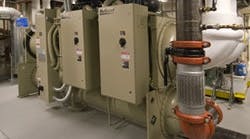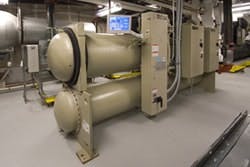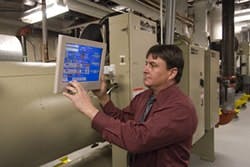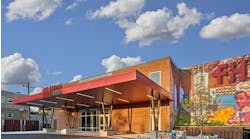MINNEAPOLIS-The McNamara Alumni Center at the University of Minnesota is designed as a campus showplace. With its granite-covered geodesic-shaped exterior and impressive 85-foot atrium, the 231,000-square-foot structure, owned by University Gateway Corporation, Minneapolis, is a combined visitor and conference center as well as office building for University staff. Because of its many functions, the McNamara Center is open during day and evening hours and on weekends. Despite its ultra-modern architecture, the building relied on a single 550-ton chiller for cooling during its first six years of operation. That's because the mechanical room was built for the single chiller only-leaving little room for chiller failures. An ultra-modern HVAC system had to wait until chiller technology was developed to the point where smaller machines with adequate capacity would fit in the room.
When frictionless chiller technology-with its small footprint-was introduced, Jon McCombs, Alumni Center operations manager for NorthMarq Corporate Solutions, the property management firm, recognized the opportunity to add redundancy to the HVAC system. However, early models were too small for the load requirements, and there wasn't enough room to add multiple units. "When McQuay introduced the 300-ton frictionless chiller, it gave us both the size and small footprint we needed to redesign the HVAC system," said McCombs. "In addition to redundancy, our goal was to reduce energy and provide significant life cycle cost savings to the building's original chiller plant."
The end result is that the 300-ton McQuay chiller runs about two-thirds of the time, with the 550-ton chiller providing redundancy and carrying larger loads. The new HVAC system reduced energy costs by 10 percent during the first year both chillers were in operation.
Meeting requirements for redundancy
When magnetic-bearing compressor technology did arrive, McCombs saw it as the solution to issues not only of redundancy, but also of energy savings and mechanical room restrictions. McCombs worked with Lindell Engineering, Minneapolis, Minn. and completed first designs around a 210-ton stainless steel plate heat exchange chiller. This design saved energy but presented maintenance limitations. Cleaning the condenser required completely taking it apart, and the stainless steel plate added to the unit's weight.
The mechanical contractor on the project, Albers Mechanical, knew of McCombs' concerns and suggested he consider McQuay's frictionless chiller, which had just been introduced to the market. "This new chiller technology appeared to give us the compact footprint and part load performance-with the added benefit of extremely quiet operation-that we needed," said McCombs. Another benefit of the new frictionless centrifugal chiller is that the shell and tube design is easier to service than the steel plate heat exchanger. The equipment supplier, Schwab Volhaber Lubratt, St. Paul, helped spec the new chiller.
McQuay frictionless magnetic-bearing compressor chiller.
McCombs' first goal was to improve energy efficiencies in the spring and fall. Because about half of the McNamara Center remains open in the evenings and on weekends for special events, McCombs thought the best energy savings would come from shifting after-hours and spring/fall responsibility to the new McQuay frictionless chiller. That would leave the 550-ton chiller for those hours when it was really needed.
Redesigning the HVAC system opened up many new discoveries about how the existing system actually operated. "For example, I already knew a 300-ton chiller could comfortably carry the building's load without sacrificing temperature or the comfort of the building," said McCombs. "That's because, during the summer of 2005, I set the original 550-ton chiller's demand limit to 60 percent, or around 300 tons. I learned that even on an 84-degree wet bulb day in July-when the outdoor temperature was 85 degrees with 91 percent humidity at around 9:30 pm-we were maintaining a 40.5-degree set point on the chilled water supply and all of the air handling units were running. For me, this proved we could consider our future chiller with 300 tons as a truly redundant system."
Jon McCombs, operations manager at the Alumni Center, has seen annual electrical energy savings of nearly $12,000 since the McQuay frictionless chiller was commissioned.
Saving on weight and sizeThe first test for the frictionless chiller was actually getting the new machine in the door. Fortunately, the compact design of the McQuay chiller-at approximately 12 feet by less than 48 inches, including the electrical panel-helped to meet code requirements. The lightweight chiller also met load limitations, because the magnetic-bearing compressor weighs a fraction of a typical centrifugal compressor. And the new chiller's quiet operation saved having to put it on a housekeeping pad, which also helped reduce weight and physical footprint.
Automatic transfer switch simplifies power-sharing
To take advantage of the existing electrical supply, McCombs installed an equipment automatic transfer switch. The switch transfers power between chillers, depending on which one is running (they don't operate at the same time). New VFDs adjust flow rates as required for each chiller's design, which are a big help in simplifying the operation and saving energy. He also installed an amp meter to monitor both chillers' electrical use from the same source. By selecting the chiller that matches the load, McCombs reduces energy and increases the life cycle of the original chiller. In addition, the new system gives him redundancy to around 85 degrees outdoor air temperature.
Another benefit is the ability to integrate with the new Johnson Controls Metasys® energy management system. The chiller communicates control and monitoring information to the Metasys system using BACnet®, the open standard protocol.
The 300-ton McQuay frictionless chiller was selected for the Alumni Center based on its weight, compact footprint, part load performance and quiet operation.
Putting it all togetherDuring its first season of operation, the McQuay chiller faced a higher number of degree days for cooling compared to the average of the past three years. Factor in the new VFDs and lower gallons per minute (GPM) in the air handling units, and the new system has saved about 169,139 kilowatt hours. At the current local electricity rate (about 7 cents/kwh), that's 10 percent less in energy costs compared to operating one non-redundant chiller system. The McQuay chiller is in use about 65 percent of the time-whenever the part load performance gives the most energy benefit. That can be as low as 0.33 kW/ton IPLV.
Seasonal runtime hours on the original 550-ton chiller have been reduced by approximately 1,800 hours. Total chiller runtime hours are approximately 3,000 hours per year.
The larger chiller operates for just over one-third of the season. "We've learned that, as the frictionless chiller gets close to full load, we achieve additional cost savings by running the larger machine at partial load," said McCombs.
Working in tandem, the two chillers give the McNamara Center the redundancy and reliability it needs. As a result, McCombs can assure University staff and guests that they can rely on the building's cooling effects even on the hottest days, while he's assured of saving valuable kilowatt hours.





